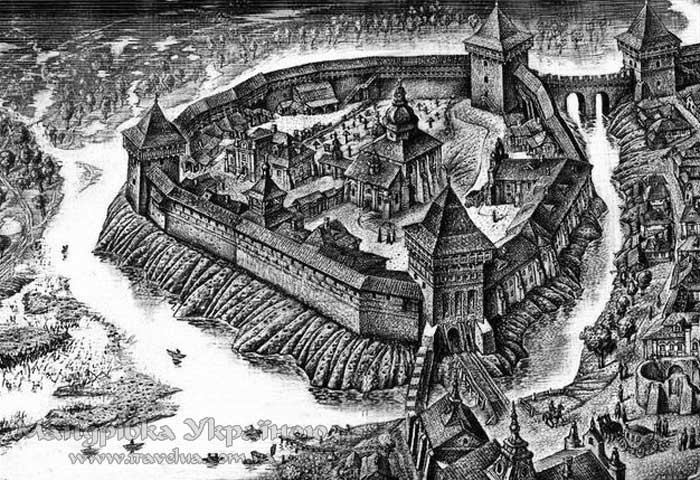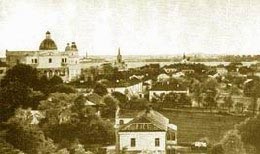Historical reference about Lutsk
Lutsk is one of the most ancient cities of Ukraine. The name “Lutsk” was first met within the Ipatiev Chronicle of 1085, when the city appeared in the center of the intestine fight between the heirs of Yaroslav the Wise. However, archaeological researches give the ground to believe that the settlement was founded in about 1000 A.D.

The most truthworthy version of the origin of the name Lutsk (ancient – Luchesk) is connected with the geographical position of the city at the bend of the river Styr. It should be mentioned that the settlement appeared on the island formed by Styr and its tributaries. This fact can be explained by defence reasons. On the present-day maps this place is indicated as the territory of the State Historical and Cultural Preserve “The Old Lutsk”.
At times of Kievan Rus, Lutsk was the capital of the local prince’s possessions that was the part of Volyn and then of Galicia-Volyn lands. In the ХІІ century Lutsk had mighty wooden fortifications. This gave the citizens of Lutsk an opportunity to withstand a six weeks’ siege in spring, 1150 by the regiments of Yuriy Dolhorukiy, the founder of Moscow. During these events his son, young prince Andrii, was close to death.
Lutsk witnessed the Tatar-Mongol invasion. The chronicles state that in 1259 the city withstood the siege of khan Kuremsa. And in 1267 prince Vasylko on demand of khan’s commander Buronday destroyed the fortifications.
Presentation of the role of Lutsk as the capital of Volyn lands is closely connected with the ruling of Lubart-Dimitri in the second half of ХІV century. It was he who changed the outward appearance of the fortifications of Lutsk having replaced wooden constructions with bricks. The son of the grand Lithuanian duke Gedymin, Lubart, was married to the local princess and became a real protector of Volyn. Under his ruling in Lutsk Castle was the seat of administrative, court and religious bodies that governed Volyn.
After Lubart’s death Lutsk remained the residence of Lithuanian and Rus princes: Vitovt (1392-1430) and Svydryhailo (1431-1452). Under Vitovt’s ruling in 1429 Lutsk housed the famous meeting of European monarchs, the main participants of which were the Lithuanian prince, Polish king Vladyslav II Yahailo, emperor Syhizmund of Luxembourg. The granting of Magdeburg right was an important moment in social, political and economical life of Lutsk citizens of ХV century. The inhabitants of Lutsk got in such a way their elective bodies of self-government.
Beginning from the late ХVІ century the Lutsk castle lost its significance as the defence stronghold but the city remains worldly and spiritual capital of the land. Because of a great number of sacral buildings contemporaries call it “Rome of Volyn” and Polish poet Sebastian Klionovic mentioned Lutsk in such words: “Who could pass Lutsk by, the city is worthy a song?”(1584).
After the Lublin Union in 1569 Volyn integrated into the Kingdom of Poland and Lutsk became the capital of a newly formed voevodship and a residence of voevods. The city gradually became more and more Polish as legal guarantee of Rus nobles and clergy were pure written promises.
With the aim of resistance to the Polish influence and Beresteiska Union (1596) an orthodox brotherhood appeared in Lutsk at the beginning of XVIII century. On September 1, 1619 the brotherhood was officially recognized by the king and was given the privilege to build a church and a shelter.
The late XVII-XVIII centuries are the period of Lutsk slow decay. Frequent fires, floods, epidemics were devastating it. The cultural and religious Ukrainian life in the city was gradually declining. In the offices and governments of voevodship Ukrainian language was replaced by Polish, and Poles took the positions of the officials.
In 1795, after the third division of Poland, the region and its capital were joined to the territory of the Russian Empire. The capital of a newly created Volyn province became Zhytomyr, and Lutsk remained the centre of the povit.
XIX century didn’t lead to the revival of economic and social life of the city. Only after the building of the south-Eastern railroad branch in 1890’s Lutsk economic rise began. At that time (1895) the population of Lutsk was 15125 people.
During the World Was I Lutsk became the battlefield of fierce combats. In summer 1915 the famous Brusylivsky Breakthrough took place in Lutsk suburbs and got into the history of the World War I.

After the February Revolution in 1917 the blue and yellow flag was hoisted above the city for the first time. In April 1917 the first Ukrainian socio-political society “Ukrainian Community” appeared. At the Hetmanat period in August 1918 the organization called “Prosvita” was created. On December 20, 1918 the detachments of the chief Symon Petliura came to Lutsk.
On May 16, 1919 Lutsk was occupied by the Polish army and according to the Riga Treaty of 1920 the Western part of Volyn got into the territory of the II Rich Pospolyta. In March 1921 Lutsk became the capital of the new Volyn voevodship. In autumn 1939 the history made its periodical change and the city became a part of the Soviet Union, became the centre of Volyn region which was composed of the Western part of the former Volyn voevodship.
On June 22, 1941 the World War II came to Lutsk, the city was occupied by the German troops. A terrible event happened before this – on June 23 about three thousand prisoners were executed in the yard of Lutsk prison by the special squad of the Soviet military forces.
In the after-war time Lutsk gradually was rebuilt and renewed. The greatest development of the city was achieved in 60’s-70’s of the XX century. In 1973 the new borders of the city territory were affirmed and now the city area equals 4267 hectares. At that time the building of powerful enterprises began: bearing plant, mélange factory and other industrial objects, that lead to the population explosion. The house-building of the big city territories began: Zavokzalny and Gnidavsky districts.
After Ukraine has gained its independence Lutsk still preserves leading positions in political, economic, cultural and religious life of Volyn. The city is one of the largest cities in the Western Ukraine (about 206 000 inhabitants). Boundary location of Volyn makes Lutsk the center of the international trade. New economical development conditions help the city to change its appearance.
